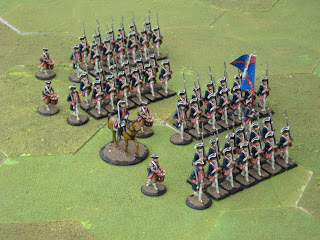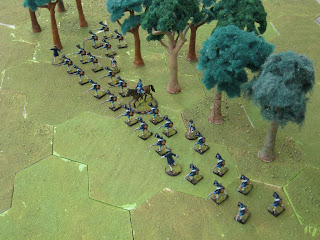Units are composed of the rank and file whose placement defines the unit's position and facing on the table and the formation it is in, plus additional officers and musicians whose presence is primarily to enhance the visual impact of the unit.
1.1. Line Infantry.
The smallest unit capable of independent action is the company. This is comprised of twelve rank and file plus associated officers and musicians. Line infantry battalions are composed of two or more companies, and may include additional battalion members (mounted CO, ensigns etc,) in its order of battle.
An infantry company in line is drawn up in no more than six files and is arranged with its flanks on two opposite hexsides. An infantry company in column is drawn up now more than three files wide and faces a hexside.
1.2. Light Infantry
Light infantry organisations follow the same rules as for line infantry, albeit generally with fewer companies to a battalion. They may use all line infantry formations and additionally may use 'open order'.
Light infantry may deploy in open order. When they do so they can take advantage of alternative rules for movement and firing. To be considered to be in open order, no more than four light infantrymen (plus any number of officers/musicians) may occupy the same hex. Infantrymen from the same company must deploy in a contiguous set of hexes.
1.3. Cavalry.
The smallest unit capable of independent action is the squadron. A squadron contains eight troopers plus associated officers and musicians. Cavalry regiments are composed of two or more squadrons, and may possess additional regiment members (CO, standard bearers etc.).
A cavalry squadron is subdivided into two troops of four troopers each. The two troops may form two lines in the same hex, or else deploy in two adjacent hexes. Each troop is arranged in a single line with its flanks resting on opposing hexsides.
Dragoon Regiment Alt-Platen In Column
1.4. Artillery.
Artillery is comprised of individual cannon accompanied by crews of 6 gunners each. Individual pieces can be organised into batteries of two or more guns with an additional mounted CO.
2.0 Movement
2.1 All movement is regulated by the hexagons into which the terrain is divided. Rates of movement are determined using the following table:
| Unit and Formation | Maximum distance |
|---|---|
| Infantry | |
| Close order, move and fire | 1 hex |
| Close order, in line | 2 hexes |
| Close order in column of route | 3 hexes |
| Close order, change formation | 2 hexes |
| Open order, move and fire | 2 hexes |
| Open order, move | 3 hexes |
| Change from open order to close or back again | 3 hexes |
| Artillery | |
| Move and 50% chance to fire | 1 hex |
| Move unlimbered | 2 hexes |
| Move limbered | 3 hexes |
| Cavalry | |
| Heavy cavalry | 4 hexes |
| Light cavalry | 5 hexes |
2.1 Cases
2.1.1. If infantry or artillery pass through one or more bad terrain hexes in a movement round, then the maximum movement distance is reduced by 1 hex (and 1 hex only regardless of the number of bad terrain hexes moved through).
2.1.2. If cavalry pass through one or more bad terrain hexes in a movement round, then the maximum movement distance is reduced by 2 hexes (and 2 hexes only regardless of the number of bad terrain hexes moved through).






